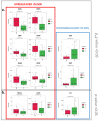Towards the Definition of the Molecular Hallmarks of Idiopathic Membranous Nephropathy in Serum Proteome: A DIA-PASEF Approach
- PMID: 37511514
- PMCID: PMC10380405
- DOI: 10.3390/ijms241411756
Towards the Definition of the Molecular Hallmarks of Idiopathic Membranous Nephropathy in Serum Proteome: A DIA-PASEF Approach
Abstract
Idiopathic membranous nephropathy (IMN) is a pathologically defined disorder of the glomerulus, primarily responsible for nephrotic syndromes (NS) in nondiabetic adults. The underlying molecular mechanisms are still not completely clarified. To explore possible molecular and functional signatures, an optimised mass spectrometry (MS) method based on next-generation data-independent acquisition combined with ion-mobility was applied to serum of patients affected by IMN (n = 15) or by other glomerulopathies (PN) (n = 15). The statistical comparison highlighted a panel of 57 de-regulated proteins with a significant increase in lipoprotein-related proteins (APOC1, APOB, APOA1, APOL1 and LCAT) and a substantial quantitative alteration of key serpins (including A4, D1, A7, A6, F2, F1 and 1) possibly associated with IMN or NS and podocyte stress. A critical dysregulation in metabolisms of lipids (e.g., VLDL assembly and clearance) likely to be related to known hyperlipidemia in IMN, along with involvement of non-classical complement pathways and a putative enrolment of ficolin-2 in sustaining the activation of the lectin-mediated complement system have been pinpointed. Moreover, mannose receptor CD206 (MRC1-down in IMN) and biotinidase (BTD-up in IMN) are able alone to accurately distinguish IMN vs. PN. To conclude, our work provides key proteomic insights into the IMN complexity, opening the way to an efficient stratification of MN patients.
Keywords: DIA-PASEF; mass spectrometry; membranous nephropathies; proteomics; serum.
Conflict of interest statement
The authors declare no conflict of interest.
Figures







References
-
- Nachman P.H., Jennette J.C., Falk R.J. Primary Glomerular Disease. In: Taal M., Brenner B., Rector F., editors. Brenner and Rector’s the Kidney. 9th ed. Elsevier/Saunders; Philadelphia, PA, USA: 2012. pp. 1100–1191.
MeSH terms
Substances
Grants and funding
- FAR 2017-2021/Fondo Ateneo-UNIMIB
- Fondazione Gigi & Pupa Ferrari Onlus/Fondazione Gigi & Pupa Ferrari Onlus
- regional law n° 9/2020, resolution n° 3776/2020": PROGRAMMA DEGLI INTERVENTI PER LA RIPRESA ECONOMICA: SVILUPPO DI NUOVI ACCORDI DI COLLABORAZIONE CON LE UNIVERSITÀ PER LA RICERCA, L'INNOVAZIONE E IL TRASFERIMENTO TECNOLOGICO: NephropaThy/Regione Lombardia
LinkOut - more resources
Full Text Sources
Miscellaneous

